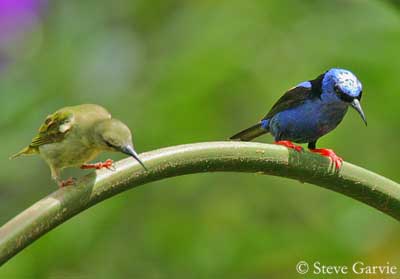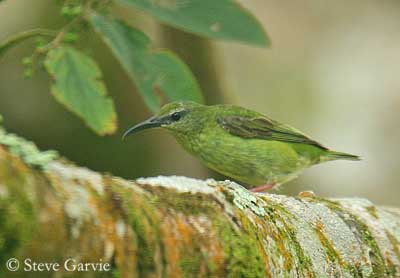
Red-legged Honeycreeper
Cyanerpes cyanus
Passeriforme Order - Thraupidae Family
BIOMETRICS:
Length: 12-13 cm; Weight: 14 g
DESCRIPTION:
Red-legged Honeycreeper is a small bird with bright colours. Male and female are very different.
Adult male in breeding plumage has black upperparts. Scapulars, rump and upper tail coverts are bright blue. Tail feathers and wings are black.
On the underparts, plumage is bright blue overall, except on lower belly, vent, undertail coverts and rectrices which are black. On the under wings, coverts and inner webs of flight feathers are bright yellow, conspicuous in flight.
Head is bright blue, but crown is rather turquoise. Lores are black as small mask, extending around the eyes. The long, blackish bill is slender and down curved. Eyes are dark brown. Legs and feet are bright red.
Adult male in basic plumage has green plumage overall, but lores are dark, and it has streaked lemon throat and underparts. Wings and tail are black.
Adult female has green head and upperparts, with brownish lores and pale stripe above the eye. Flight feathers and tail are brown.
Underparts are yellow-green, with lemon streaks on throat and breast. Belly and undertail coverts are lemon. Flanks are green. Legs and feet are pinkish-red.
Juvenile is similar to female, with brown legs.

VOICE: SOUNDS BY XENO-CANTO
Red-legged Honeycreeper utters a high-pitched “ssit” in flight. Song is a series of weak “tsip” and “chaa” repeated for several minutes.
It also utters high “shree” calls, rolled and slightly nasal “srrip”, and a rough mewing “meeah”.
HABITAT:
Red-legged Honeycreeper lives in wet evergreen forest and edges, citrus and cocoa plantations, semi-open areas with scattered trees, open woodlands and clearings.
It can be seen up to 1,200 metres of elevation.
RANGE:
Red-legged Honeycreeper lives from southern Mexico, through Central America, southwards to Peru, Bolivia and central Brazil. It is also found in Cuba, Trinidad and Tobago.
BEHAVIOUR:
Red-legged Honeycreeper is very gregarious outside breeding season. It is often seen in pairs or in small groups of up to 5 to 15 birds, but large flocks of about 100 birds can congregate at food source, such as flowering trees. It is rarely seen alone.
Red-legged Honeycreeper usually forages in canopy, searching for insects on small branches, or catching them in flight. It also feeds lower, picking ripe fruits for reaching the seeds inside.

It is able to extract the pulp of an orange through the holes made by woodpeckers. It also takes nectar from flowers, thanks to its long decurved bill. These birds are very active and restless.
Red-legged Honeycreeper can gather in flocks of 50 birds and more during migration and winter. Some populations are resident, whereas other birds migrate locally or perform altitudinal movements. These birds tend to wander in non-breeding groups after breeding season. They are not long distance migrants.
FLIGHT:
Red-legged Honeycreeper has bouncing flight, performing alternated wing beats and glides. It hovers frequently when foraging into foliage, and also to catch insects on flowers and on the wing.

REPRODUCTION:
Breeding season occurs from January to June, according to the locality.
Nest is a fibre cup, suspended by the rim from a twig, at about 3 to 15 metres above the ground, in tree or bush. Female builds the cup-shaped nest with rootlets and fibres.
She lays two white eggs with brown markings. Incubation lasts about 12 to 13 days, by female.
Young fledge about two weeks after hatching, and they are fed by both parents.
DIET:
Red-legged Honeycreeper seeks nectar and small insects in flowers. It feeds on ripe fruits, pulp and seeds, taken into the fruit, thanks to the long slender bill. It examines the underside of small twigs and leaves, in order to catch small invertebrates.
PROTECTION / THREATS / STATUS:
Red-legged Honeycreeper is locally common, according to the season, in suitable habitat.
This species is not globally threatened at this moment.
Fr: Guit-guit-saï
All : Türkisnaschvogel
Esp : Tucuso Monatñés
Ital : Cianerpe zamperosse
Nd : Blauwe Suikervogel
Photograph bird-fruit by Patrick Ingremeau
His website: TAMANDUA
Photographs pair and female by Steve Garvie
His website:
RAINBIRDER Photo galleries
Text by Nicole Bouglouan
Sources:
A GUIDE TO THE BIRDS OF COLOMBIA by Steven L. Hilty and William L. Brown
Princeton University Press – ISBN 069108372X
Arthur Grosset's Birds (Arthur Grosset)
Wikipedia (Wikipedia, The Free Encyclopedia)